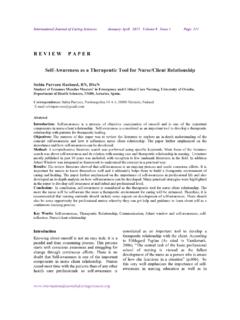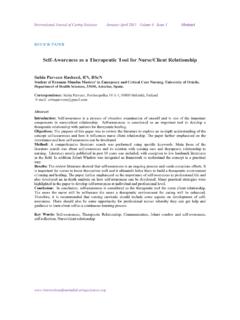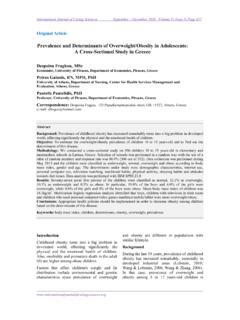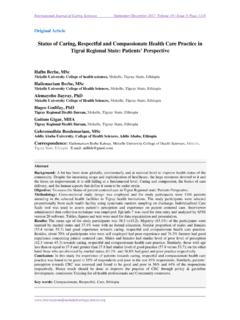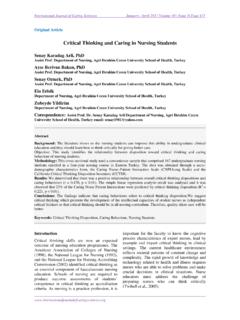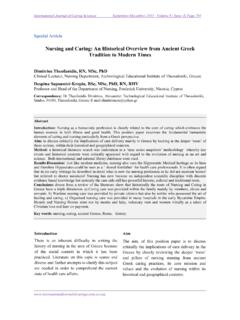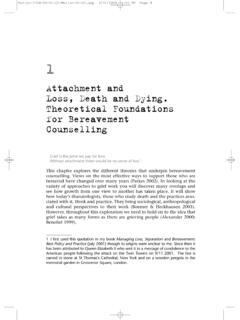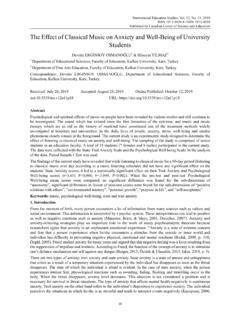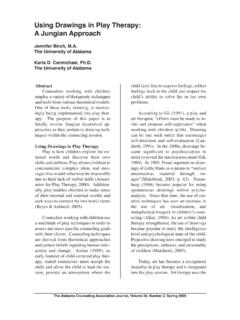Transcription of Benefits of Animal Assisted Therapy in Mental Health
1 International Journal of Caring Sciences September-December 2019 Volume 12 | Issue 3| Page 1898. Review Article Benefits of Animal Assisted Therapy in Mental Health Konstantinos Koukourikos, MSc, PhD (c). Lecturer in Nursing, Nursing Department, International Hellenic University, Thessaloniki, Greece Athanasia Georgopoulou, RN. International Hellenic University, Thessaloniki, Greece Lambrini Kourkouta, PhD. Professor, Nursing Department, International Hellenic University, Thessaloniki, Greece Areti Tsaloglidou, MSc, PhD. Assistant Professor, Nursing Department, International Hellenic University, Thessaloniki, Greece Abstract Background: Animal - Assisted Therapy is defined as the aimed interaction between trained animals and patients, which is considered complementary to conventional therapies.
2 It is designed and implemented by a team of experts including the therapist, the Animal handler, and some Health professionals. Aim: The aim of this study is to present and highlight the role of animals and their advantages in the treatment of Mental illness Methodology: Extensive review of the recent literature was conducted in electronic databases (Pubmed, Google scholar) and scientific journals (Greek and international) using the appropriate key words: Animal Assisted Therapy , Mental illness, aging, Animal Assisted activity, Animal companionship, Health , pet ownership and a combination of them. Results: Treatment animals are more often dogs, horses, dolphins, birds, and generally animals having gentle nature. The treatment's Benefits to the Health of mentally ill are related to reducing the expression of the negative symptoms of the disease, developing skills in various areas of patients' personality and moreover improving their quality of life.
3 A prerequisite for the proper implementation of treatment programs is compliance with basic terms and principles for the protection of Health , security and well-being of the participants. Conclusion: Prerequisites for the development of this particular therapeutic effort are the definition of treatment parameters, the proper education of Health professionals, the coordinated action of a multidisciplinary team trained specifically for its design and implementation and the expansion of the research area. Key words : Animal Assisted Therapy , Mental illness, aging, Animal Assisted activity, Animal companionship, Health , pet ownership Introduction many researchers and Health professionals had been developed with regard to the positive From ancient times, human existence is closely consequences of the interaction of animals with related to the presence of animals.
4 The animals humans and its potential Health Benefits (Hughes followed a parallel course with human either et al, 2019). initially as livelihood (food) or later domestication of some of them as a means of The studies referring to the above mentioned livelihood (eg plowing fields) and later as interaction have been multiplied and the interest domestic animals for purely personal pleasure has mainly focused on the help that Animal and well-being. contact can provide for the treatment of multiple diseases, particularly those related to Mental The presence of animals relieves, relaxes and Health . The results of these studies have led to discharges people from tension and stress of the consolidation of a complementary or everyday life.
5 The use of animals for therapeutic alternative form of treatment for various types of purposes, although has a long history, has been Mental illness, known as " Animal - Assisted expanded just in the 20th century. The interest of Therapy " (Mandr et al, 2019). International Journal of Caring Sciences September-December 2019 Volume 12 | Issue 3| Page 1899. The presence of animals as a treatment criteria in the therapeutic process as an integral and vital part of it, aiming at improving the The use of interaction with animals specially cognitive, emotional, social and physical trained for this purpose is applied to improve functions of the patient. It is designed and patient's Mental , social, emotional and physical implemented by healthcare specialists who have functions.
6 The treatment sessions can take place been further trained for these programs and can at various facilities and involve activities such as take place in a variety of facilities such as game, sports and Animal care. They are done hospitals, clinics and other rehabilitation areas, individually or in groups, and like any other form nursing homes, prisons, private homes and of treatment, they are tailored to suit each Animal farms. In this form of treatment, as well patient's needs (Jackson, 2012). as in the rest, the progress of its course and the The animals involved in the treatment are mainly evaluation of achievement of the initial dogs, cats and dolphins. However, if appropriate objectives for each patient, are recorded. It is and possible, farm animals such as horses, addressed to individual patients or groups of rabbits and various birds are also included in the patients according to the design and objective programs.
7 It is well documented in the literature criteria that have been set. Animal Assisted that the presence of animals in treatment can Therapy does not depend on any particular cause feelings of calm and optimism both in psychological theory, but can be incorporated adults and children. At the same time, it helps to into various types of them (Delta Society, 2008, establish trust between the patient and the Friedmann and Son, 2009). therapist, encouraging the achievement of B. Animal - Assisted activities: therapeutic goals. Animal - Assisted Therapy does not constitute an individual psychotherapy school These are opportunities for contacting patients nor is likely to have positive results for all people with specially trained animals, coordinated by with all sorts of disorders (Ogilvie, 2016).
8 Expert professionals or volunteers, in the absence of treatment program and specific treatment Wide Benefits of Animal Assisted Therapy in goals. Visits of animals to patients'. Mental Health accommodation are spontaneous, without Animal contact has an important place in the presupposing the recording and evaluation of lives of many people, as their presence alone can their progress. In the Animal Assisted activity contribute to their peace and well-being. context, participants were able to develop interest However, it seems that animals offer much more in themselves, other residents, and their than just companionship. Their involvement to environment, due to feelings of ease and the the treatment of Mental illness is a fact for development of one-on-one relationships with several decades, and the Benefits obtained are the AAA animals.
9 (Kawamura, Niiyama, significant. The multiplicity of terminology Niiyama, 2009, Kruger and Serpell, 2010, Crippa existed until a few years ago on the therapeutic and Feij , 2014). use of the animals and its implications, caused C. Animal Assisted intervention: confusion to the experts and made it imperative to define fixed concepts, common and widely This concept refers to the broader field of accepted. Undoubtedly, any patient's approach integration of Animal Assisted Therapy into from an Animal to a hospital or clinic is not educational programs aimed at training Health included in the treatment if certain basic professionals to organize and implement such conditions are not met (Kruger and Serpell, treatment programs (Crippa and Feij , 2014).)
10 2010). The "Delta Society", one of the largest Animal Assisted programs are being implemented organizations in the United States, which is to support children, adolescents, adults and responsible for the organization and provision of elderly patients suffering from Mental disorders. Animal Assisted programs, has adopted the The Benefits are achieved through interaction following definitions regarding the inclusion of with the trained animals, whether it is related to animals in the therapeutic context (Delta Society, touching and treating them, or simply by 2008) : observing the Animal and its relationship with its A. Animal - Assisted Therapy : trainer-carer. These potential Benefits stem from the fact that contact with animals is a potent It is a targeted and structured therapeutic supportive source for the patient due to the program that involves animals meeting specific International Journal of Caring Sciences September-December 2019 Volume 12 | Issue 3| Page 1900.
